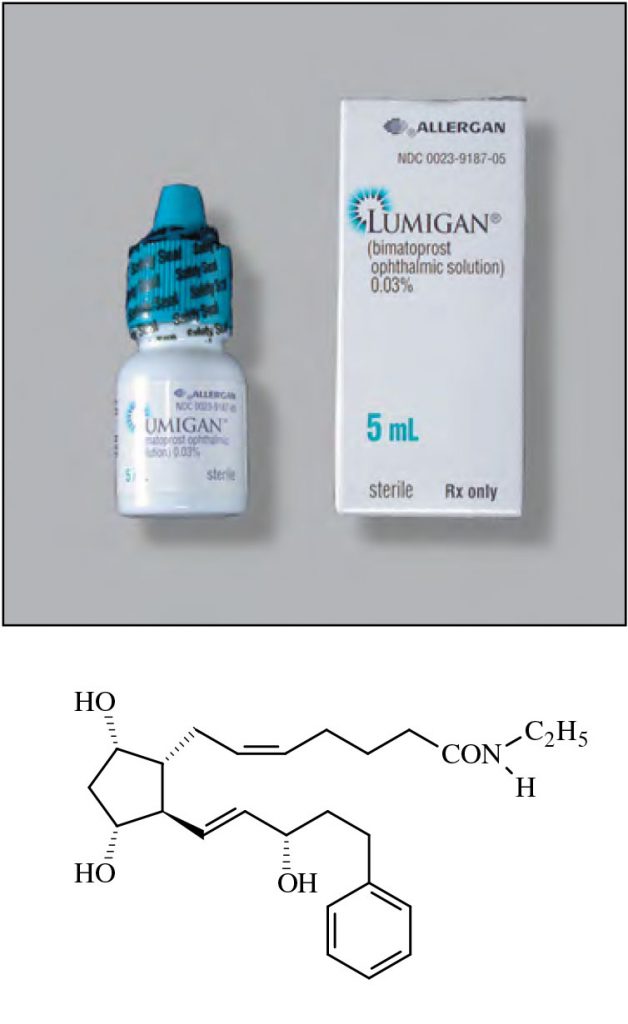
bī/möt’ ə/prōst
Brand Names: Lumigan®, Latisse®
- Generic Available
Common Dosage Forms:
- Ophthalmic solution: 0.01% and 0.03%
- Ophthalmic solution (Latisse): 0.03%* *Latisse is indicated to increase eyelash growth including length, thickness and darkness and is not covered on this card.
FDA Indications/Dosages:
- For the reduction of elevated intraocular pressure in patients with open-angle glaucoma or ocular hypertension who are intolerant of other intraocular pressure lowering medications or insufficiently responsive (failed to achieve target IOP determined after multiple measurements over time) to another intraocular pressure lowering agent: The recommended dose is one drop in the affected eye or eyes once daily in the evening. More frequent administration than once daily has been shown to decrease the intraocular lowering effect.
Monitor:
IOP
Pharmacology/Pharmacokinetics:
Elevated intraocular pressure is a significant cause of glaucomatous vision loss. Bimatoprost is a synthetic analog of prostaglandin which mimics the effects of naturally occurring prostamides. It acts on the trabecular meshwork and uveoscleral routes and increases the outflow of aqueous humor thereby lowering intraocular pressure. Bimatoprost acts locally without significant systemic action. After absorption, metabolism occurs rapidly via oxidation, N-deethylation and glucuronidation. Elimination half-life is approximately 45 minutes.
Drug Interactions:
Lumigan should not be administered while wearing contact lenses. If another ocular drug is being given to a patient, doses of Lumigan and the additional drug should be separated by at least 5 minutes.
Contraindications/Precautions:
Bimatoprost may permanently change the pigmentation and growth of the eyelashes and increase the pigmentation of the iris and periorbital tissue (eyelid). Use with caution in patients with active intraocular inflammation. Rare cases of macular edema have been reported during use of bimatoprost ophthalmic solution. Use with caution in aphakic patients, in pseudophakic patients with a torn posterior lens capsule, and in patients with known risk for macular edema. Pregnancy Category C.
Adverse Effects:
The most frequent adverse effects reported in clinical trials (15 to 45% of patients) include, in decreasing order of incidence: conjunctival hyperemia, growth of eyelashes, and ocular pruritus. Less frequent effects (3 to 10%) include ocular dryness, visual disturbances, ocular burning, foreign body sensation, eye pain, pigmentation of the periocular skin, blepharitis, cataract, superficial puncate keratitis, eyelid erythema, ocular irritation, and eyelash darkening.
Patient Consultation:
- Bimatoprost may cause a brown pigmentation in the iris, eyelashes, and eyelids and increase the growth of eyelashes. Be advised that treatment of only one eye may make these changes more obvious.
- To instill: Lie down or tilt head backward and look up (holding dropper above eye), drop solution inside lower lid, and make sure dropper does not come in contact with eye or fingers.
- Wait at least 5 minutes before instilling other ophthalmic preparations.
- Remove contact lenses prior to use and wait at least 15 minutes after each dose before reinserting.
- Avoid squinting or closing of eyes tightly after instilling drops.
- Do not discontinue therapy without first consulting a physician.
- Store in a cool, dry place away from sunlight and children.
- If a dose is missed instill it as soon as possible. If it is closer to the time of your next dose than the dose you missed, skip the missed dose and return to your dosing schedule.
- Contact a physician if the above side effects are severe or persistent.